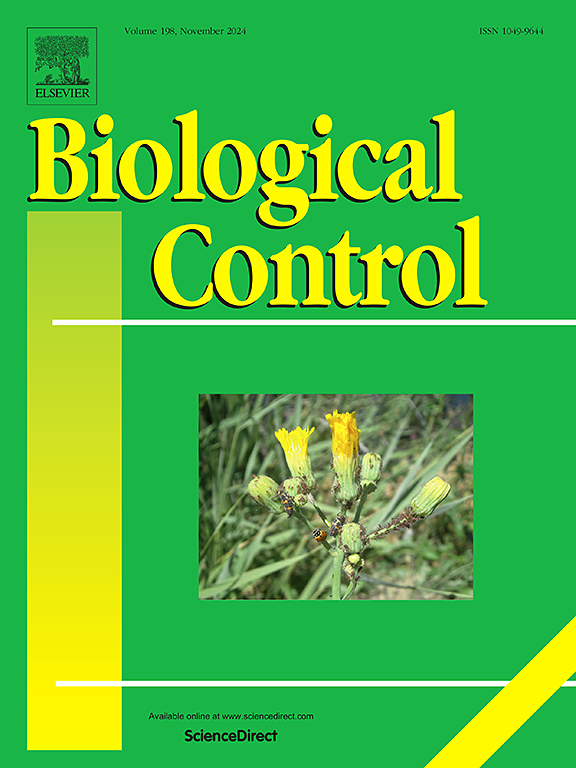Potential biocontrol services by seven aphid predators for the control of Aphis nerii infesting Mandevilla
IF 3.4
2区 农林科学
Q2 BIOTECHNOLOGY & APPLIED MICROBIOLOGY
引用次数: 0
Abstract
Aphids are an important economic pest in protected crops and, among them, Aphis nerii Boyer de Fonscolombe is considered a key pest of the ornamental Mandevilla plant. This aphid can produce damage that can severely reduce the aesthetic and commercial value of ornamental plants. For the development of successful biological control strategies, information on prey suitability and predator’s functional response is essential. In this study, we first evaluate the suitability of A. nerii as a food source for seven commercial generalist predators, as well as their ability to suppress aphid population. The tested predator species were: Chrysoperla carnea Stephens (Neuroptera: Chrysopidae), Sphaerophoria rueppellii Wiedmann (Diptera: Syrphidae), Episyrphus balteatus DeGeer (Diptera: Syrphidae), Micromus angulatus Stephens (Neuroptera: Hemerobiidae), Propylea quatuordecimpunctata L. (Coleoptera: Coccinellidae), Adalia bipunctata L. (Coleoptera: Coccinellidae), and Sympherobius fallax Navas (Neuroptera: Hemerobiidae). Then, we assessed the predation rates and the functional response of C. carnea, M. angulatus, and P. quatuordecimpunctata preying on A. nerii. The first two experiments demonstrated that M. angulatus, P. quatuordecimpunctata, and S. rueppellii can survive, develop, and reproduce on A. nerii. Aphis nerii resulted in unsuitable prey for the remaining predators, as they displayed low foraging efficiency, survival and negligible impact on aphid population density. From the functional response study, it was observed that C. carnea did not show a significant response to varying densities of A. nerii. In contrast, both M. angulatus and P. quatuordecimpunctata exhibited a Type II functional response. Among these, the brown lacewing (M. angulatus) demonstrated superior predatory efficiency, with a higher attack rate and a shorter handling time compared to the lady beetle (P. quatuordecimpunctata). Although further studies are needed to understand the complex predator–prey dynamics, this study identifies promising candidates as biological control agents of A. nerii.

7种天敌蚜虫对防治曼德拉黑蚜的潜在生物防治作用
蚜虫是保护作物中重要的经济害虫,其中蚜虫被认为是观赏植物曼德拉的主要害虫。这种蚜虫可以造成损害,严重降低观赏植物的美学和商业价值。为了制定成功的生物控制策略,有关猎物适宜性和捕食者功能反应的信息是必不可少的。在本研究中,我们首先评估了沙蚕作为7种商业多面手捕食者食物来源的适宜性,以及它们对蚜虫种群的抑制能力。被试捕食物种有:大黄茧蜂(神经翅目:蛱蝶科)、大黄茧蜂(双翅目:蛱蝶科)、大黄茧蜂(双翅目:蛱蝶科)、小角茧蜂(神经翅目:蛱蝶科)、四角茧蜂(鞘翅目:瓢虫科)、双斑茧蜂(鞘翅目:瓢虫科)、黄茧蜂(神经翅目:蛱蝶科)和黄茧蜂(神经翅目:蛱蝶科)。在此基础上,研究了三种昆虫的捕食率和捕食功能反应。前两项实验表明,角棘棘球蚴、四足足棘球蚴和鲁氏棘球蚴可以在棘球蚴上生存、发育和繁殖。蚜虫的觅食效率低,成活率低,对蚜虫种群密度的影响微不足道,是其他天敌的不适宜猎物。从功能响应研究中可以看出,不同密度的褐刺草对褐刺草的响应不显著。与此相反,斑叶鳗和四爪鳗均表现出II型功能反应。其中,褐草蛉(M. angulatus)的捕食效率比瓢虫(P. quatuordecimpunctata)高,攻击率高,处理时间短。虽然需要进一步的研究来了解复杂的捕食者-猎物动态,但本研究确定了有前途的候选生物防治剂。
本文章由计算机程序翻译,如有差异,请以英文原文为准。
求助全文
约1分钟内获得全文
求助全文
来源期刊

Biological Control
生物-昆虫学
CiteScore
7.40
自引率
7.10%
发文量
220
审稿时长
63 days
期刊介绍:
Biological control is an environmentally sound and effective means of reducing or mitigating pests and pest effects through the use of natural enemies. The aim of Biological Control is to promote this science and technology through publication of original research articles and reviews of research and theory. The journal devotes a section to reports on biotechnologies dealing with the elucidation and use of genes or gene products for the enhancement of biological control agents.
The journal encompasses biological control of viral, microbial, nematode, insect, mite, weed, and vertebrate pests in agriculture, aquatic, forest, natural resource, stored product, and urban environments. Biological control of arthropod pests of human and domestic animals is also included. Ecological, molecular, and biotechnological approaches to the understanding of biological control are welcome.
 求助内容:
求助内容: 应助结果提醒方式:
应助结果提醒方式:


